Papers by Gottfried Spangler
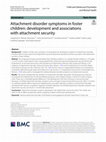
Child and Adolescent Psychiatry and Mental Health, Aug 11, 2023
Background Children in foster care constitute a risk population for developing symptoms of attach... more Background Children in foster care constitute a risk population for developing symptoms of attachment disorders. However, little is known about the longitudinal course of attachment disorders and their association with attachment security in foster children. Method This longitudinal study assessed attachment disorder symptoms in a sample of foster children (n = 55) aged 12 to 82 months. Foster parents with a newly placed foster child were assessed at three points during the first year of placement. At all assessment points, the Disturbance of Attachment Interview (DAI; Smyke and Zeanah in Disturbances of attachment interview, Tulane University, New Orleans, 1999) and the Attachment Q-sort (AQS; Waters and Deane in Monogr Soc Res Child Dev 50:41-65, 1985 German version as reported(Schölmerich and Leyendecker in Deutsche Übersetzung des attachment behavior Q-Set, revision 3.2. Unpublished manual, Ruhr UniversityBochum, Bochum, 1999) were used to investigate the interplay between disorder symptoms and attachment security. Results The results revealed that the symptoms of attachment disorders decreased. The decrease was more pronounced for the inhibited than for the disinhibited symptoms with marked changes in the first 6 months of placement. There was a noticeable gender difference in the development with boys showing a more pronounced decrease in inhibited attachment disorder symptoms and a stronger increase of attachment security. After 12 months, no significant gender effects were found. Regarding the association between symptoms of attachment disorders and attachment security, a significant negative correlation between the inhibited attachment disorder symptoms and attachment security was found 12 months after placement. Conclusions Attachment disorder symptoms decreased in the stable foster care environment. Thus, foster care seems to be an effective placement option regarding children's attachment development.
Frontiers in Psychology, Dec 5, 2017
Bundesgesundheitsblatt-gesundheitsforschung-gesundheitsschutz, Sep 12, 2016

Developmental child welfare, Aug 4, 2023
Foster care offers children a safe family environment and is effective in buffering the negative ... more Foster care offers children a safe family environment and is effective in buffering the negative effects of early adversity. Specifically, foster care has been found to facilitate secure attachment to foster parents. However, there are limited data on attachment development in children entering foster care after the first year of life. In this study, we examined attachment behaviour and representations as well as symptoms of reactive attachment disorder (RAD) and disinhibited social engagement disorder (DSED) in 3–6 year-old foster children. We studied two subgroups of foster children with different preplacement experiences (Group 1: children entering foster care after living in institutions; Group 2: children entering foster care after living with their biological families) and compared them with a community sample. The results revealed that children in both foster care groups showed significantly lower attachment security at the behavioural level, higher hyperactivation and disorganization at the representational level, and significantly more symptoms of RAD and DSED than the children in the control group. Analyses did not indicate significant differences between the foster care groups. Moreover, no significant associations were found between attachment-related variables and preplacement experiences. This may be an indication that in long-term foster care, the quality of foster care becomes the major factor affecting a child’s attachment development. Thus, foster parents need supportive services and interventions with a focus on attachment development.
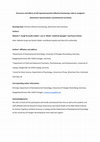
Parental reflective functioning is thought to provide a missing link between caregivers' own atta... more Parental reflective functioning is thought to provide a missing link between caregivers' own attachment histories and their ensuing parenting behaviors. The current study sought to extend research on this association involving 115 parents, both mothers and fathers, of 5-to-6-year-old preschoolers using the German version of the Parental Reflective Functioning Questionnaire (PRFQ). Our study was the first to combine Adult Attachment Interview classifications of parental attachment, behavioral observations of parental sensitivity and PRFQ ratings while drawing on a sizable father subsample. We found theoretically consistent significant relations between all measures, while our results particularly highlighted the role of dismissing attachment for decreases in parenting quality on both cognitive and behavioral levels as the dismissing status differentially affected specific components of self-reported parental reflective functioning and observed sensitivity. Interestingly, these patterns were largely comparable in mothers and fathers. Exploratory mediation analyses further suggested that decreased parental reflective functioning may partially mediate the relationship between parents' dismissing attachment and decreased parental sensitivity. Thus, for prevention and intervention programs targeting parental sensitivity and thus children's long term healthy mental development, the interplay between parental reflective functioning and parents' own attachment history emerges as a key mechanism. Finally, our study served as a further validation of the Parental Reflective Functioning Questionnaire (PRFQ) given the caveat that the prementalizing scale may need further revision in the German version.
Attachment & Human Development, Oct 12, 2022

Attachment & Human Development, May 1, 2014
Both traumatic experiences in their birth families and multiple placement histories lead to incre... more Both traumatic experiences in their birth families and multiple placement histories lead to increased mental health problems in foster children. The formation of secure attachments to new caregivers could be a protective factor for foster children. The current study focused on the associations between foster parents' sensitivity, parenting stress and foster children's attachment behavior as well as behavior problems. The sample consists of 48 children (aged from 1 to 6 years) and their foster caregivers. Attachment behavior and sensitivity were observed during home visits. Furthermore, caregiver reports were used to assess parenting stress and children's behavior problems. Compared to normative data, foster children showed lower levels of attachment security and more behavior problems. Foster children's attachment security and behavior problems were predicted significantly or marginally by foster parents' stress and supportive presence.
Psychologie in Erziehung Und Unterricht, Dec 19, 2022
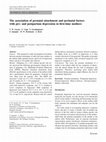
Zeitschrift Fur Geburtshilfe Und Neonatologie, Nov 1, 2011
Purpose This prospective study investigated associations between prenatal attachment of adult fir... more Purpose This prospective study investigated associations between prenatal attachment of adult first-time mothers to the unborn child, perinatal factors and levels of depression before and up to 18 months after delivery. Method Primiparas (N = 161) without specific risk factors answered the following questionnaires during the last term of pregnancy (t1): Edinburgh Postnatal Depression Scale (EPDS), Maternal Antenatal Attachment Scale (MAAS), questionnaire on the schema of the unborn child, and a questionnaire about the pregnancy. Perinatal data were taken from the patients' files. The EPDS was answered 3 weeks (t2, N = 157), 6 months (t3, N = 159), and 18 months (t4, N = 132) postpartum. Results During pregnancy, 16.9 % of the women indicated mild depressive symptoms, and 7.5 %, medium to severe symptoms of depression. Mild symptoms of depression were found in 25.5 % at t2, 10.1 % at t3, and 12.2 % at t4; medium to severe symptoms were reported by 7.6, 1.9 and 5.6 %, respectively. Women with low control during delivery (emergency Caesarean) showed a tendency for higher levels (p = 0.067) of depression at t3 than women with elective Caesarean did. The quality of prenatal attachment to the unborn child correlated negatively with depressive symptoms at t1-t4. Conclusions The closer the prenatal attachment of a mother to her unborn child, the less symptoms of depression she reports during the last term of pregnancy and postpartum. Therefore, promoting good mother-child attachment during pregnancy might influence the level of postpartum depression.
Psychotherapie Psychosomatik Medizinische Psychologie, Feb 1, 2011
Bundesgesundheitsblatt-gesundheitsforschung-gesundheitsschutz, 2016
The aim of the study was to investigate biobehavioural organisation in infants with different qua... more The aim of the study was to investigate biobehavioural organisation in infants with different qualities of attachment. Q uality of attachment (security and disorganisation), emotional expression, and adrenocortical stress reactivity were investigated in a sample of 106 infants observed during A insworth' s Strange Situation at the age of 12 months. In addition, behavioural inhibition was assessed from maternal reports. A s expected, securely attached infants did not show an adrenocortical response. R egarding the traditionally de® ned insecurely attached groups, adrenocortical activation during the strange situation was found for the ambivalent group, but not for the avoidant one. Previous ® ndings of increased adrenocortical activity in disorganised infants could not be replicated.
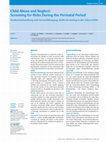
Geburtshilfe Und Frauenheilkunde, May 1, 2012
Purpose: Currently, there is a claim for earlier interventions for families in order to prevent c... more Purpose: Currently, there is a claim for earlier interventions for families in order to prevent child maltreatment. Here, a screening instrument to assess risk indicators for child abuse and neglect already in the context of maternity clinics is introduced. The present study is the first report on the psychometric properties of this instrument, the "short questionnaire for risk indices around birth" (RIAB). Material and Methods: Data were collected in the context of three different studies conducted at Ulm University Hospital. To examine interrater reliability eight case vignettes were rated by n = 90 study participants (50 students and 40 experts working at a maternity clinic). Criterion validity was examined in two studies applying the German version of the child abuse potential inventory CAPI (n = 96 families at risk and n = 160 additional families). Results: Both laymen and experts were able to understand and use the screening instrument correctly, leading to a high agreement with the sample solutions given. A high concordance was found between parentsʼ and expertsʼ ratings: In case of no reported risk factors applying the screening instrument RIAB, parents themselves reported significantly less stressors and burdens, compared to those parents with an indication for a thorough examination as pointed out in the RIAB. Conclusion: In the context of maternity clinics the RIAB is a useful, broadly applicable instrument, screening for existing risk factors at the earliest and thus allowing for the initiation of specific interventions when needed.

Psychologie für den Lehrberuf, 2019
Dieses Kapitel ist in zwei grose Abschnitte eingeteilt. Im ersten Abschnitt gehen wir auf die mot... more Dieses Kapitel ist in zwei grose Abschnitte eingeteilt. Im ersten Abschnitt gehen wir auf die motivationale Entwicklung und die Interessenentwicklung ein. Warum beschaftigen sich Schulerinnen und Schuler ausdauernd mit Hobbys, warum lernen sie mal mehr, mal weniger gerne? Was bewegt bzw. motiviert uns zu unseren Tatigkeiten? Der vorliegende Beitrag zur Motivationsentwicklung ist entsprechend dreier fur die Beschreibung und Erklarung motivationsbezogener Phanomene wesentlicher Fragen strukturiert: (1) Mochte ich diese Aufgabe erledigen und warum mochte ich das? (2) Traue ich mir zu, diese Aufgabe zu bearbeiten? (3) Wie muss ich vorgehen, um diese Aufgabe erfolgreich zu bewaltigen (vgl. Eccles, Wigfield & Schiefele 1998; Wigfield, Eccles, Fredricks, Simpkins, Roeser & Schiefele 2015)? Im zweiten Abschnitt werden die emotionale Entwicklung und das Konzept der Bindung erlautert. Die emotionale Entwicklung eines Kindes ist stark mit der Entwicklung der kindlichen Bindungen mit seinen Bez...
Attachment & Human Development, 2021
The Effect of Religiosity and Religious Festivals on Positional Concerns: An Experimental Investi... more The Effect of Religiosity and Religious Festivals on Positional Concerns: An Experimental Investigation of Ramadan * This paper examines the effect of religion on positional concerns using survey experiments. We focus on two of the dimensions of religion-degree of religiosity and religious festivals. By conducting the experiments during both the most important day of Ramadan (the Night of Power) and a day outside Ramadan, we find that Ramadan overall has a small and negative impact on positional concerns. Detailed analyses based on the sorting of individuals' degree of religiosity reveal that the decrease in the degree of positional concerns during Ramadan is mainly explained by a decrease in positionality among individuals with a low degree of religiosity. We also discuss the broader welfare implications of our findings.
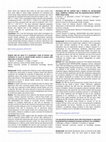
Journal of Psychosomatic Research, 2015
1.763); psychological abuse increases the probability of reporting GIS (OR = 1.65, 95% CI = 1.269... more 1.763); psychological abuse increases the probability of reporting GIS (OR = 1.65, 95% CI = 1.269-2.151), while the sexual abuse was also associated with this type of symptoms (OR = 2.52, 95% CI = 1.347-4.717). The most prevalent reported symptoms were diarrhea, constipation, abdominal pain and indigestion. The Results also indicate that as the exposure to ACEs categories increases the odds for experiencing these types of symptoms increase as well. Conclusion: This is the first Romanian study which investigates the relationship between traumatic childhood experiences and psychosomatic health problems in a national representative university sample. Considering the high prevalence of these events and the strong relationships between exposure to adverse experiences and psychosomatic health problems, several preventive, counselling and national policy recommendations will be presented.

Uploads
Papers by Gottfried Spangler